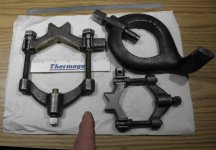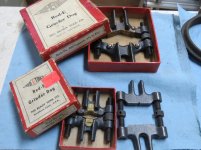Metal-Masher
Plastic
- Joined
- Dec 5, 2018
Last week I posted this question in the South Bend Lathe section, but it didn't get much action there. I think it would have been better if I had posted it here instead.
I bought a group of several vintage dog legs and in the bunch was this large one. It has no markings on it.
One individual did comment that it was for transferring a work piece from one faceplate to another.
Do you know the purpose and era of this tool?
Many thanks,
Alex
I bought a group of several vintage dog legs and in the bunch was this large one. It has no markings on it.
One individual did comment that it was for transferring a work piece from one faceplate to another.
Do you know the purpose and era of this tool?
Many thanks,
Alex










